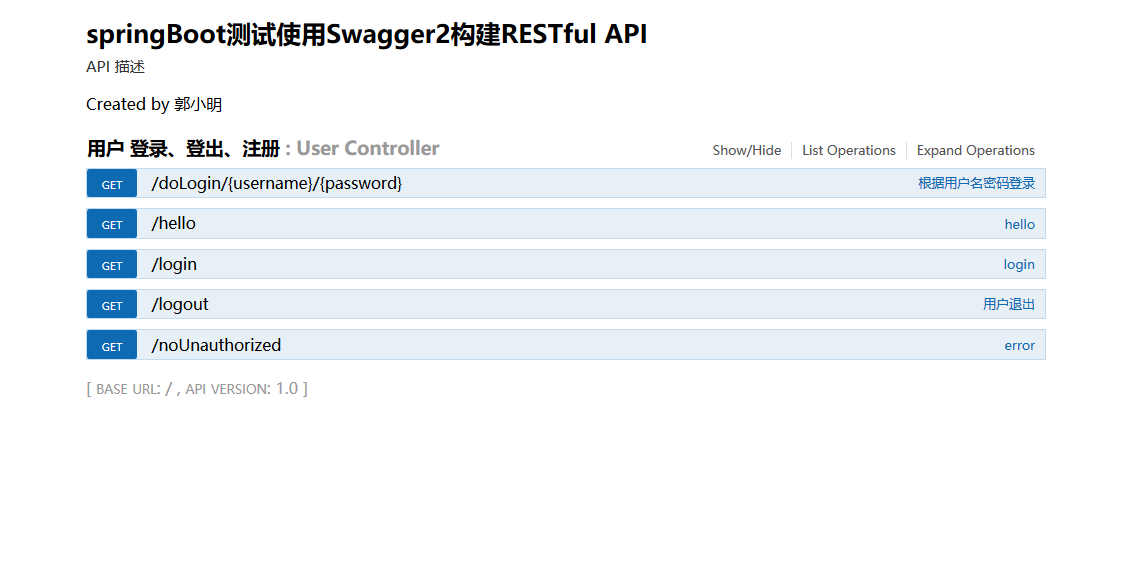开发工具:STS
前言:
对外提供一个Api,无论是对开发、测试、维护,都有很大的帮助。
下面我们来实现swagger2。
参考实例:https://blog.csdn.net/weixin_39477597/article/details/79639239
实例:
1.添加依赖:
1 <dependency> 2 <groupId>io.springfox</groupId> 3 <artifactId>springfox-swagger2</artifactId> 4 <version>2.7.0</version> 5 </dependency> 6 <dependency> 7 <groupId>io.springfox</groupId> 8 <artifactId>springfox-swagger-ui</artifactId> 9 <version>2.7.0</version> 10 </dependency>
2.配置:
package com.xm.shiro.config;
import org.springframework.context.annotation.Bean;
import org.springframework.context.annotation.Configuration;
import springfox.documentation.builders.ApiInfoBuilder;
import springfox.documentation.builders.PathSelectors;
import springfox.documentation.builders.RequestHandlerSelectors;
import springfox.documentation.service.ApiInfo;
import springfox.documentation.service.Contact;
import springfox.documentation.spi.DocumentationType;
import springfox.documentation.spring.web.plugins.Docket;
import springfox.documentation.swagger2.annotations.EnableSwagger2;
@Configuration
@EnableSwagger2
public class SwaggerConfig {
@Bean
public Docket docket(){
return new Docket(DocumentationType.SWAGGER_2).apiInfo(apiInfo()).select()
// 当前包路径
.apis(RequestHandlerSelectors.basePackage("com.xm.shiro.controller"))
.paths(PathSelectors.any()).build();
}
//构建api文档的详细信息函数
private ApiInfo apiInfo(){
return new ApiInfoBuilder()
//页面标题
.title("springBoot测试使用Swagger2构建RESTful API")
//创建人
.contact("郭小明")
//版本号
.version("1.0")
//描述
.description("API 描述")
.build();
}
}
3.在controller中引用api:
注解说明:
@Api():作用于类上,表示这个类是swagger的资源。
tags = ”说明该类的作用“
@ApiOperation():用在请求的方法上,说明的方法的用户和作用
value=“说明方法的用途、作用”
notes="方法的备注说明“
@ApiImplicitParams():用在请求的方法上,表示一组参数说明,可以包含多个@ApiImplicitParam()
@ApiImplicitParam():指定一个请求参数的各个方面
name:参数名
value:参数的汉字说明
required:参数是否必须传
dataType:参数类型
defaultValue:参数的默认值
@ApiResponses():用在请求的方法上,表示一组响应。可以包含多个@ApiResponse()
@ApiResponse():用于表示一个错误的响应信息
code:数字
message:信息
response:抛出异常的类
@ApiModel():用在响应类上,表示一个返回响应数据的信息。
@ApiModelProperty():用在属性上,描述响应类的属性
package com.xm.shiro.controller; import org.apache.shiro.SecurityUtils; import org.apache.shiro.authc.AuthenticationException; import org.apache.shiro.authc.IncorrectCredentialsException; import org.apache.shiro.authc.UsernamePasswordToken; import org.apache.shiro.authz.annotation.RequiresPermissions; import org.apache.shiro.authz.annotation.RequiresRoles; import org.apache.shiro.subject.Subject; import org.springframework.web.bind.annotation.GetMapping; import org.springframework.web.bind.annotation.PathVariable; import org.springframework.web.bind.annotation.RequestMapping; import org.springframework.web.bind.annotation.RestController; import io.swagger.annotations.Api; import io.swagger.annotations.ApiOperation; @Api(value="UserController",tags="用户 登录、登出、注册") @RestController public class UserController { @RequiresPermissions("hello") @GetMapping("/hello") public String hello() { return "Hello Shiro!"; } @GetMapping("/login") public String login() { return "权限管理"; } @ApiOperation(value="根据用户名密码登录",notes="用户登录") @GetMapping("/doLogin/{username}/{password}") public String doLogin(@PathVariable("username") String username,@PathVariable("password") String password) { UsernamePasswordToken token = new UsernamePasswordToken(username, password); Subject currentUser = SecurityUtils.getSubject(); try { currentUser.login(token); //此步将 调用realm的认证方法 } catch(IncorrectCredentialsException e){ //这最好把 所有的 异常类型都背会 return "密码错误"; } catch (AuthenticationException e) { return "登录失败"; } currentUser.hasRole("sun"); currentUser.hasRole("sun"); currentUser.hasRole("sun"); currentUser.hasRole("sun"); return token.getPrincipal()+":登录成功"; } @ApiOperation(value="用户退出",notes="注销用户") @GetMapping("/logout") public String logout() { Subject currentUser = SecurityUtils.getSubject(); currentUser.logout(); return "退出登录"; } @GetMapping("/noUnauthorized") public String error() { return "无权限"; } }
4.登录http://localhost:8080/swagger-ui.html,查看api
